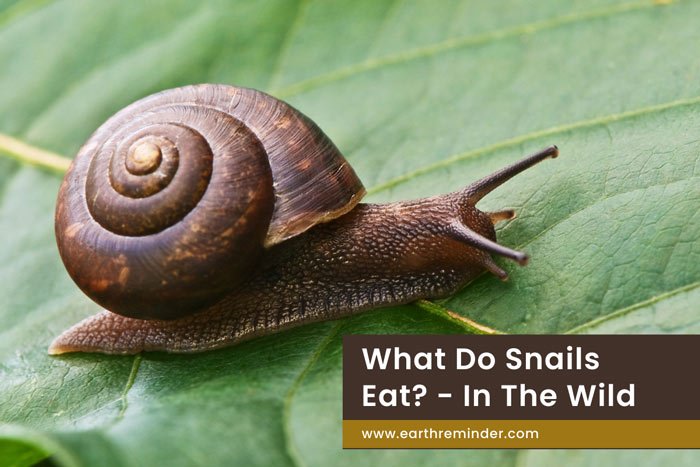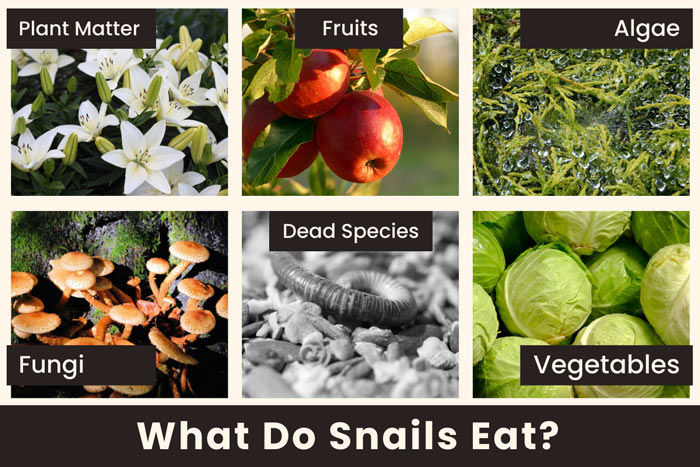What Do Snails Eat? – In The Wild
What do snails eat in the wild? Many people have this question. The answer could surprise you! Species like snails have unique diets based on their habitat and surroundings. Although some snails eat leaves, others consume vegetables and fruit. Newborn snails initially consume the same foods as their parents, but as they grow, they form their own tastes. In some instances, snails will consume other creatures as well! Let’s look at it in more detail.
Table of Contents
What Do Snails Eat In The Wild?
Snails feed on various foods in the environment based on their species and region. Listed below are the multiple foods snails consume in the wild.
Plant Matter
Plant matter has become one of the most frequent food sources for snails in the wild. They consume various plant materials, such as leaves and stems. Although some snail species favor particular kinds of plants, many others will eat anything. Because they consume a lot of plant material, snails can harm gardens and crops.
Fruits
Snails eat many fruits, including apples, mangoes, kiwis, strawberries, and bananas. Fruits like these provide snails with essential nutrients, water, and sugars. Snails have a radula, a specialized feeding organ, which helps them scrape and eat soft fruit parts.
Algae
Algae is a common food source for snails in marine habitats and freshwater ecosystems. The aquatic plant known as algae provides snails with a wealth of nutrients. In places where alternative food sources are uncommon, certain species of snails can even extract nutrients from the strong cell walls of algae, making them a valuable food source.
Dead Animals
Some snail species, often called decomposers, feed on dead animals. They might be observed feeding on the decomposing meat of other dead animals. Although it may appear an unpleasant food source, it is an essential ecosystem component. Snails aid in the decomposition of dead animals or the recycling of their nutrients throughout the environment.
Also Read: What Do Snails Do for The Environment?
Fungi
Fungi are another food source for snails in the wild. Fungi are a particular organism that may flourish under various conditions, including soil, dead organic debris, and even on trees. Snails are a crucial ecosystem member because they can extract nutrients from fungi. They eat conchs or mushrooms, Tree bark or rock covered with fungi, among many others. Snails consume invasive fungi and prepare the substrate for fungal growth by grazing live grass.
Vegetables
There are many vegetables that snails eat, including sweet corn, sprouts, green beans, cucumbers, watercress, broccoli, turnips, lettuce, mushrooms, and peas. The important thing to remember is that snails have individual preferences, and they prefer certain vegetables over others.
What Do Wild Snails Drink?
Snails require moisture to survive, but unlike humans or other creatures that drink water, they do not actually “drink” water (until necessary). Snails absorb small amounts of moisture through their skin. In the wild, snails acquire moisture from sources such as dew, rain, and other humid conditions in their environment. Snail species also obtain moisture from the food and plants they consume.
Is The Diet of All Snails Identical?
Unlike some people believe, snails do not eat the same thing. Some snails eat vegetables and fruits, while others eat leaves. Some snails even feed on other species. A snail’s diet can vary depending on its habitat, available food sources, and individual preferences.
What Types of Food Do Snails Avoid in Their Natural Habitat?
Snails are sluggish animals that are known to devour a variety of different foods. However, there are some things that snails in the wild tend to stay away from. Here are some examples of foods that snails in the wild avoid:
- Poisonous Plants: Snails have developed the ability to recognize harmful plants and stay away from them. They can detect the presence of poisons in the plant, which will prevent them from protecting their bodies from injury. For example, snails simply don’t like the milky sap of Euphorbia plants.
- Woody Plants: Since their mouths cannot break down hard or woody plants, snails have been unfit to consume them. They often cling to softer, more digestible vegetation, like succulents.
- Plants With Tough Fibers: Similar to how they steer clear of tough-fibered plants like bamboo or grass, snails do the same. The snail may experience stomach problems since these plants can be hard to digest.
- Plastic Objects: Since they cannot digest metal or plastic, snails in the wild usually stay away from these materials. These items can also harm the snail if they eat them, damaging their internal organs or causing them to choke.
- Dry or Wilted Plants: Fresh, moist vegetation is preferred by snails. They will avoid dry or wilted plants since they are less tasty and might not provide sufficient moisture to meet the snail’s requirements.
Also Read: How Does Energy Flow Through an Ecosystem?
Conclusion
Snails can be plant-eaters, meat-eaters, or both, or even enjoy feasting on decaying waste from plants and animals. Wild snails are adaptive feeders and will eat anything that’s available. They typically eat multiple plants, including leaves, flowers, fruits, rotting plant waste, and fungi. Although less frequent, snails are also found to consume worms, tiny insects, and other snails. Due to their assistance in decomposing organic matter and recycling nutrients, their feeding habits play a significant role in the ecosystem. Snails can also harm crops, so they are also considered pests in some agricultural contexts. Overall, snails in the wild have a varied and diverse diet that enables them to survive in various situations.

